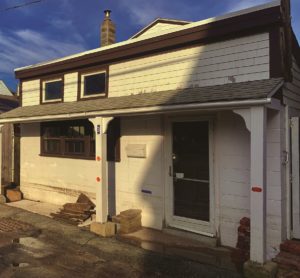PROVINCETOWN — It has been almost three weeks since an extreme high tide, whipped into violent waves by a strong southeast wind, flooded parts of Provincetown’s East End with seawater. Several dozen homes had their ground floors or basements flooded, especially in the area where Howland Street and Daggett Lane meet Bradford Street, roughly between the Icehouse condominiums and the East End Market.

Even outside that immediate region, there are homes that are now uninhabitable because of seawater intrusion into basements, which can destroy the electrical panels, boilers, and other equipment that keep homes warm in winter. Without heat, even homes that are otherwise undamaged have to be evacuated and the pipes emptied lest freezing temperatures burst the pipes and create a second flood of tap water come spring.
The damage to residential infrastructure has displaced several of Provincetown’s year-round households — but even town staff don’t know exactly how many are affected. Not everyone asks for help or needs a physical rescue, and people who have moved in with friends may not be known to any town departments.
“There were five households here at the Crown & Anchor immediately after the storm,” said owner Jonathan Hawkins, who put out word during the storm that free rooms were available at his hotel for people displaced by floodwaters.
Assistant Town Manager Dan Riviello contacted Hawkins within the hour, Hawkins said, to secure shelter for two people who had just been evacuated from their flooded apartment.
“Four of those households are still staying with us,” Hawkins said. “Two of them have been told that their units will probably not be safe for another three weeks.”
The owner of those two units told Hawkins that insurance adjusters have been hard to get over the holidays, and their answers about what will and won’t be paid for are maddeningly vague.
Some properties could take much longer than three weeks to restore. When subfloors, insulation, wiring, and boilers all need to be replaced, the timeline can stretch to months before a home can be inhabited again.
Community Support
Four separate online fundraising campaigns have raised more than $180,000 for some of the people affected by the storm, including many who were thrown out of work when two businesses flooded.
A fundraiser to support the year-round employees of Fanizzi’s Restaurant while it is closed had raised $78,519 when this edition of the Independent went to press, while another to support the employees of the East End Market had raised $38,038.
A third fundraiser, to support longtime residents Michael Fernandes and Susumu Kishihara, had raised $47,282, while a fourth, to support Jeanmarie, Dylan, and Brendan Kaeselau, had raised $19,675.
The Crown & Anchor raised an additional $7,500 at holiday weekend fundraisers for people affected by the flood, which brings the total of those five efforts to more than $190,000.
Marc Guerrette, who is helping distribute the money that the Crown & Anchor raised over Christmas and New Year’s, said he wanted to focus on people who were displaced from their homes, but no list of such people exists. Building Commissioner Annie Howard said more than 100 properties experienced some kind of physical damage, but she did not know which or how many of those properties were occupied.
Water Rescues
While a list of those affected may be elusive, stories of steadfast community support are everywhere. Dozens of volunteer firefighters joined the town’s police officers, Dept. of Public Works employees, town staff, and other community members to help people in need, especially during the storm itself.
Volunteer firefighter Malcolm Hunter worked with firefighters Noah Santos, Kevin Ainsworth, Cody Hutchison, and Vaughn Cabral to help Michael Fernandes, who uses a wheelchair, out of his basement apartment. Their yellow “Mustang” immersion suits and the camouflage-green truck they drove led many people to speculate they were National Guardsmen, Hunter said, but that truck is actually the Provincetown Fire Dept.’s high-water rescue truck. The U.S. military surplus vehicle was acquired after two of the town’s fire trucks were totaled by saltwater during the January 2018 flood, Hunter said.
Water was still rising inside Fernandes’s apartment when the firefighters arrived. It was above Fernandes’s waist, Hunter recounted, and it was cold enough to generate hypothermia as well. Hunter had been watching the waves from Flyer’s Boatyard, his summer employer, before that, and he had thought the high tide was going to pass without too much damage when the calls started to come in.
“It was that last foot, right at the very end of the tide,” that pushed the harbor into a flood, Hunter said. Nearly everyone on Howland Street mentioned how fast the floodwaters came — but were it not for a “perfect wind direction” and those last moments of high tide, the waters might not have invaded at all.



